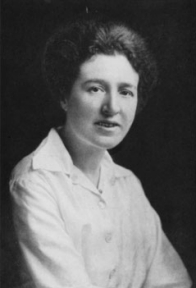Related Research Articles

Isabel Clifton Cookson was an Australian botanist who specialised in palaeobotany and palynology.

Agnes Robertson Arber FRS was a British plant morphologist and anatomist, historian of botany and philosopher of biology. She was born in London but lived most of her life in Cambridge, including the last 51 years of her life. She was the first woman botanist to be elected as a Fellow of the Royal Society and the third woman overall. She was the first woman to receive the Gold Medal of the Linnean Society of London for her contributions to botanical science.

Elsie Quarterman was a prominent plant ecologist. She was a Professor Emerita at Vanderbilt University.

Daphne J. Osborne was a British botanist. Her research in the field of plant physiology spanned five decades and resulted in over two hundred papers, twenty of which were published in Nature. Her obituary in The Times described her scientific achievements as "legendary"; that from the Botanical Society of America attributed her success to "her wonderful intellectual style, combined with her proclivity for remarkable and perceptive experimental findings".
Áskell Löve was an Icelandic systematic botanist, particularly active in the Arctic.
Doris Benta Maria Löve, néeWahlén was a Swedish systematic botanist, particularly active in the Arctic.
Kristi S. Anseth is the Tisone Distinguished Professor of Chemical and Biological Engineering, an Associate Professor of Surgery, and a Howard Hughes Medical Investigator at the University of Colorado at Boulder. Her main research interests are the design of synthetic biomaterials using hydrogels, tissue engineering, and regenerative medicine.

Lucy Beatrice Moore was a New Zealand botanist and ecologist.
Haskett is an English surname of Norman origin. People bearing the name include:
Pauline Yvonne Ladiges is a botanist whose contributions have been significant both in building the field of taxonomy, ecology and historical biogeography of Australian plants, particularly Eucalypts and flora, and in science education at all levels. She is professorial fellow in the School of Botany at the University of Melbourne, where she has previously held a personal chair and was head of the School of Botany at the University of Melbourne from 1992 to 2010. She has been a fellow of the Australian Academy of Science since 2002. The standard author abbreviation Ladiges is used to indicate this person as the author when citing a botanical name.
Pamela Soltis is an American botanist. She is a distinguished professor at the University of Florida, curator at the Florida Museum of Natural History, principal investigator of the Laboratory of Molecular Systematics and Evolutionary Genetics at the Florida Museum of Natural History, and founding director of the University of Florida Biodiversity Institute.

Hazel Marguerite Schmoll (1890–1990) was an American botanist, and the first to conduct a systematic study of plant life in southwestern Colorado. She was also the first woman to earn a doctorate in botany from the University of Chicago. She was inducted into the Colorado Women's Hall of Fame in 1985.
Beverley Jane Glover, is a British biologist specialising in botany. Since July 2013, she has been Professor of Plant Systematics and Evolution in the Department of Plant Sciences at the University of Cambridge and Director of the Cambridge University Botanic Garden.

Diana Harrison Wall is the Founding Director of the School of Global Environmental Sustainability, a Distinguished Biology Professor, and Senior Research Scientist at the Natural Resource Ecology Laboratory at Colorado State University. She is an environmental scientist and a soil ecologist and her research has focussed on the Antarctic McMurdo Dry Valleys. Wall investigates ecosystem processes, soil biodiversity and ecosystem services and she is interested in how these are impacted by global change. The Wall Valley was named after her in recognition of her research in the McMurdo Dry Valleys. Wall is a globally recognised leader and speaker on life in Antarctica and climate change.

Elizabeth Edgar was a New Zealand botanist, best known for her work in authoring and editing three of the five volumes of the series Flora of New Zealand, which describes and classifies the species of flora of the country. She was most noted for her taxonomic work on the biodiversity of New Zealand and was recognised as the foremost authority on nomenclature and description of the country's plants.
Beryl Brintnall Simpson is a professor emerita in the Department of Integrative Biology at the University of Texas at Austin. Previously she was an associate curator at the Smithsonian National Museum of Natural History in the Department of Botany. She studies plant systematics and tropical botany, focusing on angiosperms found in the American Southwest, Mexico, and Central and South America. She was awarded the José Cuatrecasas Medal for Excellence in Tropical Botany for her decades of work on the subject.

Patricia Holmgren is an American botanist. Holmgren's main botanical interests are the flora of the U.S. intermountain west and the genera Tiarella and Thlaspi. Holmgren was the director of the herbarium at the New York Botanical Garden from 1981–2000, and editor of Index Herbariorum from 1974–2008.
Jean H. Langenheim was an American plant ecologist and ethnobotanist, highly respected as an eminent scholar and a pioneer for women in the field. She has done field research in arctic, tropical, and alpine environments across five continents, with interdisciplinary research that spans across the fields of chemistry, geology, and botany. Her early research helped determine the plant origins of amber and led to her career-long work investigating the chemical ecology of resin-producing trees, including the role of plant resins for plant defense and the evolution of several resin-producing trees in the tropics. She wrote what is regarded as the authoritative reference on the topic: Plant Resins: Chemistry, Evolution, Ecology, and Ethnobotany, published in 2003.
Geneva Sayre was a bryologist and bibliographer. She "pioneered bibliographical and historical bryology, a new field in the study, evaluation, and organization of the literature of bryology."
Katharine Nash Suding is an American plant ecologist. Suding is a Distinguished Professor of ecology and evolutionary biology at the University of Colorado Boulder and a 2020 Professor of Distinction in the College of Arts and Sciences.
References
- ↑ Bock, Jane (17 November 2015). Forensic Plant Science. Academic Press. p. xi. ISBN 9780128015810 . Retrieved 31 March 2016.
- ↑ "Jane H. Bock". www.janehbock.com. Archived from the original on 2014-07-16. Retrieved 2016-03-31.
- ↑ "Jane H. Bock". www.janehbock.com. Archived from the original on 2014-07-16. Retrieved 2016-03-31.
- ↑ "Jane H. Bock - Awards, Certificates and Memberships". www.janehbock.com. Archived from the original on 2016-01-22. Retrieved 2016-03-31.
- ↑ "Jane H. Bock - Awards, Certificates and Memberships". www.janehbock.com. Archived from the original on 2016-01-22. Retrieved 2016-03-31.